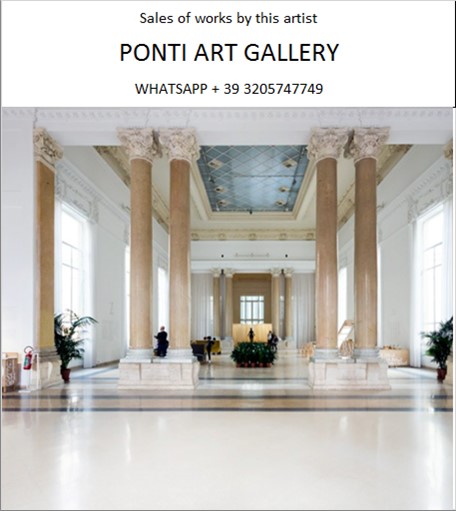Ponti Art Gallery is interested in buying and selling works
of art by this artist.

Asger Jorn Biography
Donald Clarence Judd, born on June 3, 1928, in Excelsior Springs, Missouri, was a pivotal figure in the postwar American art scene, renowned for his contributions to the Minimalist movement. His work, characterized by its emphasis on the physical presence of form in space, eschewed traditional notions of representational sculpture, instead focusing on the creation of specific objects that occupy their environment in a manner that is both straightforward and enigmatic.
Judd's early life was marked by frequent relocations due to his father's work for the Western Union Telegraph Company. This nomadic childhood took him across various states, from Omaha to Philadelphia, and instilled in him a sense of adaptability and independence. His formative years were also influenced by summers spent on his grandparents' farm in Missouri, where he developed a deep connection to the land and rural architecture—a theme that would later permeate his work.
After graduating from high school, Judd enlisted in the United States Army, serving in Korea from June 1946 until November 1947. This experience allowed him to take advantage of the GI Bill, which subsequently funded his higher education. Upon his return to the United States, Judd pursued his academic interests at the College of William and Mary, the Art Students League of New York, and Columbia University, where he completed a Bachelor of Science in philosophy in 1953. He later returned to Columbia to study art history, working under esteemed scholars such as Rudolf Wittkower and Meyer Schapiro.
Judd's early artistic endeavors were in painting, but by the early 1960s, he had shifted his focus to three-dimensional work, which he felt offered greater potential for innovation and expression. His first solo exhibition, held at the Green Gallery in New York in 1963, marked the beginning of his exploration into the spatial dynamics that would define his career. Judd's work from this period was characterized by its use of industrial materials such as Plexiglas, metal, and plywood, and its precise, machine-made appearance, which removed any trace of the artist's hand.
Throughout his career, Judd wrote extensively on art, architecture, and design, contributing criticism to major art magazines and publishing influential essays. His seminal text "Specific Objects" (1965) articulated the principles of Minimalism, advocating for artworks that exist as self-referential entities without illusionistic depth or metaphorical meaning. Judd's insistence on the autonomy of the art object and its direct engagement with the viewer's space and perception was revolutionary.
In 1968, Judd purchased a five-story cast-iron building at 101 Spring Street in New York, which he meticulously renovated to house his living and working spaces, as well as his growing collection of art. This building became a prototype for his later architectural projects and installations, reflecting his belief in the importance of the permanent installation of artwork.
Judd's influence extended beyond the confines of the gallery space. In the early 1970s, he began acquiring properties in Marfa, Texas, where he established large-scale installations and architectural interventions that integrated art with the surrounding landscape. These projects culminated in the creation of the Judd Foundation and the Chinati Foundation, which serve to preserve his legacy and promote his vision of art in harmony with its environment.
Judd's work has been exhibited extensively in the United States, Europe, and Asia, with major retrospectives at institutions such as the Whitney Museum of American Art, the National Gallery of Canada, and Tate Modern. His pieces are held in numerous museum collections worldwide, attesting to his enduring impact on the fields of art, architecture, and design.
Donald Judd passed away on February 12, 1994, in New York City, but his radical ideas and the body of work he left behind continue to provoke thought and inspire artists and architects around the globe. His legacy is one of challenging conventions and redefining the relationship between art, space, and the viewer, making him one of the most significant artists of the twentieth century.
Asger Jorn Quotes and Sales of
Works
Ponti Art Gallery selects and deals with paintings by the
artist. Upon request, we provide free estimates and
evaluations, communicate prices, quotations, and current
market values.
If you are interested in BUYING or SELLING works by the
artist, contact us immediately.
If you wish to sell or receive an evaluation of the
works:
Send us a frontal photo of the painting, one of the back,
and one of the signature. Also, indicate the dimensions of
the work. Inform us about the purchase origin of the work
and any kind of available documentation (purchase
receipts, certificates of authenticity, publications). One
of our operators will respond to you on the same day. We
guarantee maximum confidentiality and extreme
professionalism.
If you wish to purchase works by the painter: Contact us
and let us know your request. We will inform you about the
available works. We also offer the possibility to
subscribe to our NEWSLETTER, through which you will be
informed at the beginning of each month about the latest
acquisitions of the art gallery.
You can send us pictures of the work:
